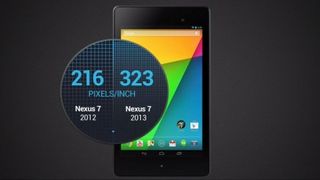While the Amazon Kindle Fire HD 7-inch contains an identically sized 7-inch display, it can only produce a 1280 x 800 resolution and a pixel density of 216 ppi.

It might surprise you to learn that the iPad mini's display is even less sharp. A combination of it being bigger (7.9-inches) and lower res (1024 x 768) results in a pixel density of just 163 ppi - roughly half that of the new Nexus 7. Still, it remains a clear, crisp and responsive display in its own right.
New Nexus 7 vs iPad mini vs Kindle Fire HD 7-inch: storage
As we've already mentioned in the pricing category, all three tablets come in 16GB and 32GB models. Only the iPad mini differs by also offering a 64GB version - at quite a premium, it has to be said.
This is especially important as none of these devices comes with a microSD slot, so you can't expand the default storage amounts post-purchase.
All three manufacturers have attempted to mitigate the issue of storage through their own cloud storage initiatives. Google's is arguably the most fully formed and tightly integrated, with services such as Google Drive, Google+ and its extensive online media library all reducing the need to store quite so much data locally.
Amazon's cloud offering is also quite robust, and as mentioned its Silk UI is built around the cloud-based Amazon media ecosystem. Apple's iCloud arguable brings up the rear, although it stores your photos and documents reasonably efficiently.
New Nexus 7 vs iPad mini vs Kindle Fire HD 7-inch: camera and speakers
Both the new Google Nexus 7 and the Apple iPad mini contain 5-megapixel rear cameras for taking pictures and 1080p video, while the Amazon Kindle Fire HD has none.
Get daily insight, inspiration and deals in your inbox
Get the hottest deals available in your inbox plus news, reviews, opinion, analysis and more from the TechRadar team.
It also loses out when it comes to its front-facing camera, which is merely listed as "HD." The Nexus 7 and the iPad mini equivalents are both 1.2-megapixel units, which will result in sharper video calls.
New Nexus 7 vs iPad mini vs Kindle Fire HD 7-inch: connectivity
The new Nexus 7 supports dual-band Wi-Fi 802.11 a/b/g/n, as well as Bluetooth 4.0, HDMI out (via an adaptor) and NFC. There's also an LTE model that will enable you to use 4G networks if available in your country.
For its part, the iPad mini also supports dual-band Wi-Fi 802.11a/b/g/n, Bluetooth 4.0 and HDMI out (again, via an adapter). Apple has yet to jump aboard the NFC bandwagon just yet, though. It too supports 4G networks, including the U.K.'s first next-gen network on EE.
The Kindle Fire HD is Wi-Fi only, but again it supports 802.11a/b/g/n standards. Its dual MIMO Wi-Fi antennae (which the iPad Mini also has) ensures speedy and stable wireless download performance. Bluetooth 3.0 is featured, which is a lesser standard than on the other two devices.
New Nexus 7 vs iPad mini vs Kindle Fire HD 7-inch: dimensions and weight
Google claims that the new Nexus 7 will be a whopping 50 grams lighter than the previous model, which by our calculations will make it weigh just 290 grams. That compares favorably to the 395 gram Kindle Fire HD and even the 312 gram iPad mini.
The Nexus 7 isn't as skinny as Apple's super-svelte tablet, though. While the new iteration is said to be almost 2mm thinner than the first Nexus 7 - so around 10.4mm - it's still some way fatter than the 7.2mm iPad mini.
Meanwhile, the Kindle Fire HD also appears to be marginally slimmer than the new Nexus 7 at 10.3mm.
However, where the new Nexus 7 really stands apart is in its narrowness. With 6mm shaved off of the original's side bezels it's now a mere 114mm wide, which will make it extremely easy to grip one-handed or slip into a mid-sized pocket. The iPad mini by contrast is 134mm wide, and the Kindle Fire HD a relatively chunky 137mm.
Most Popular

